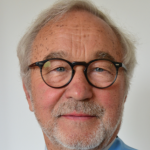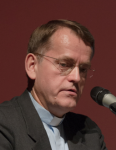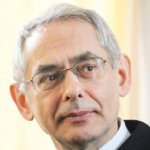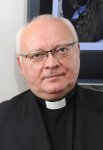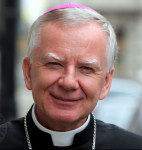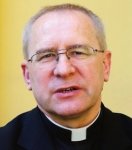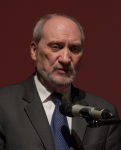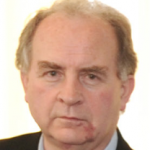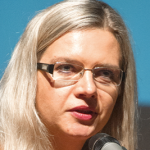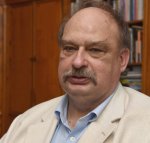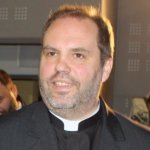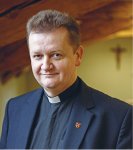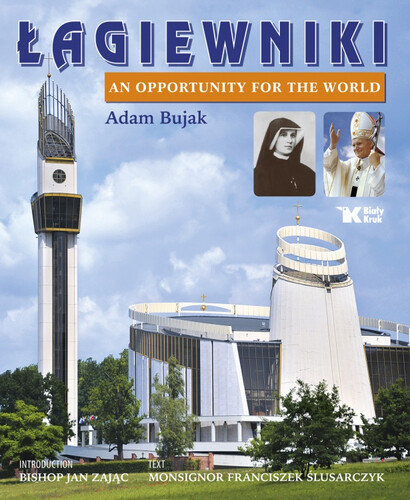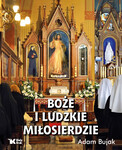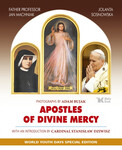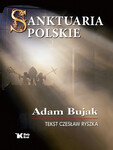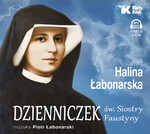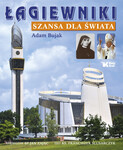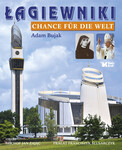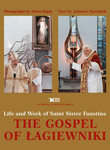Łagiewniki. Szansa dla świata (ang) // Łagiewniki. An opportunity for the world
| liczba stron: | 176 |
| obwoluta: | tak |
| format: | 205x250 mm |
| papier: | 150 g kreda błysk |
| oprawa: | twarda lakierowana |
| data wydania: | 18-07-2012 |
| ISBN: | 978-83-7553-139-8 |
 dodaj do przechowalni
dodaj do przechowalni
Podczas konsekracji bazyliki Bożego Miłosierdzia 17 sierpnia 2002 r. Jan Paweł II wyraził przekonanie, iż "jest to także szczególne miejsce, które Bóg obrał sobie, aby tu wylewać łaski i udzielać swego miłosierdzia". Wiemy, że słowa Błogosławionego Papieża sprawdziły się.
Po 10 latach od tamtego momentu do sanktuarium w Łagiewnikach przybywa co roku ponad 1,5 miliona pielgrzymów z wszystkich kontynentów! Bazylika Bożego Miłosierdzia gości wydarzenia religijne o randze światowej, zaś cały kompleks sanktuarium stał się miejscem zbiorowego przeżywania smutków (np. katastrofa smoleńska) i radości (np. beatyfikacja Jana Pawła II) całego narodu. Przed cudownym wizerunkiem Jezusa Miłosiernego i relikwiami św. Siostry Faustyny modlił się również Papież Benedykt XVI.
Liczne, specjalnie urządzone kaplice, nowoczesne zagospodarowanie i przemyślana infrastruktura sprawiają, że pielgrzymi znajdują w Łagiewnikach doskonałą przestrzeń do modlitwy, głębokiej refleksji i odnalezienia duchowego spokoju. W pobliżu zaś powstaje szybko Centrum Jana Pawła II "Nie lękajcie się" - sanktuarium Błogosławionego, wielkiego czciciela i apostoła Bożego Miłosierdzia - które w przyszłości ma być bezpośrednio połączone z sanktuarium łagiewnickim. Wspaniały rozkwit sanktuarium w Łagiewnikach - dziś Światowego Centrum Kultu Bożego Miłosierdzia - na swych niezrównanych fotografiach ukazał jego wieloletni świadek i wybitny artysta, krakowianin Adam Bujak. Obrazowi wtórują słowa ks. prałata Franciszka Ślusarczyka, zastępcy rektora sanktuarium.
1. Mercy: the spring of hope, address from Bishop Jan Zając
2. God rich in Mercy, Father Franciszek Ślusarczyk
3. In the glory of Divine Mercy, Father Franciszek Ślusarczyk
4. St Sister Faustina Kowalska
5. Congregation of Sisters of Our Lady of Mercy
6. Canonisation of Sister Faustina
7. Construction of the new Basilica
8. Modern architecture of the sanctuary
9. Consecration of the Basilica of Divine Mercy
10. First anniversary of the death of John Paul II
11. Pilgrimage of Benedict XVI
12. Day of the Sick
13. Construction of the Be not Afraid John Paul II Centre
14. The panoramic tower
15. Christmas
16. Crash of the presidential plane in Smolensk - mourning mass
17. Chapel of Perpetual Adoration of the Holy Sacrament
18. Chapel of St Sister Faustina
19. The Chapel of Our Lady of Seven Dolours
20. The Communio Sanctorum Chapel
21. Chapel of the Holy Cross
22. The Greek Catholic Chapel of St Andrew the Apostle
23. Beatification of John Paul II - introduction of the relics
24. 2nd World Congress of Divine Mercy
25. John Paul II Hall
26. Pilgrimage of employers and entrepreneurs
27. Holy Week
28. Divine Mercy Sunday - 2012
29. Pilgrimage of the Greek Catholics from Slovakia
30. Holy mass for evangelisation of Kraków - 2012
31. Winter in Łagiewniki
God rich in mercy
These words, so full of hope, became not only the guiding idea of John Paul II’s encyclical on Divine Mercy,1 but also the motto of his last pilgrimage to Poland in 2002. Its main goal was to consecrate the new basilica in Kraków’s district of Łagiewniki, and to entrust the whole world to Divine Mercy. Portraying the main objective of the event, the Holy Father said, “I have arrived in Łagiewniki to consecrate this new place of worship. For I am convinced that it is a special place, one that God chose to dispense graces and bestow His Mercy here. I pray that this church will always be the place where the message of the merciful love of God is preached; and a place of repentance and penance; a place to celebrate the sacrifice of the Eucharist – the source of Mercy – the constant entreatment for the Mercy of God for us and for the whole world.”2
1. The ark of salvation for our times
Despite a plethora of scientific and technical achievements, the contemporary person feels an ever-growing spiritual void. What is therefore subconsciously sought is a powerful point of support, and predominantly the light and the hope that give an opportunity for salvation here on Earth, and allow a trustful look towards happy eternity. The architect and designer of the new basilica, Professor Witold Cęckiewicz, admitted that many onlookers associate the church with a contemporary ship – the sign of salvation. “For what is the church today, if not an ark on the turbulent waves of our times, capable of accommodating all those who seek shelter? The tower can then be treated as a lighthouse guiding the pilgrims to where the peaceful part of the land which is their destination lies. One that they have reached when they enter the sanctuary.”3
Situated centrally in the church is a tabernacle in the shape of the Earth, with the contours of the continents. The Eucharistic Christ waits there for everyone, while the symbolical trees torn with wind and yielding to the weight though devoid of leaves symbolise the fate of contemporary man, who begins a true life only after a personal encounter with Jesus and experience of His mercy. The image of merciful Jesus situated over the tabernacle lets the arriving pilgrims perceive his anxiety for the salvation of every person in the eyes of the Saviour. The pierced palms and feet of Jesus, and the streams of grace stemming from His Heart, are a precious reminder that Divine Grace may reach every heart that opens to accept the gift in the holy sacraments. Calling for the trust of the congregation who enter the church is the “stone from Golgotha” situated in the porch. It is a meaningful expressive seal of God’s love for people, which was manifested in the road of the cross of Jesus and his death on the tree of the cross. A special place of experiencing divine forgiveness is the confessionals, where the priests – servants of Mercy – spend entire days “behind bars” to return true freedom of the heart to all the sinners standing before God “in the Spirit and truth”.
The altar of the church in Łagiewniki is made of Carrara marble, much like the pulpit, which turns the place into the Cenacle – a meaningful house of prayer. There is a place here for everyone who hears in their hearts the invitation from the Saviour: “Come unto me, all ye that labour and are heavy laden, and I will give you rest” (Matthew 11, 28). The divine table, anointed during the consecration of the church by Blessed John Paul II, gathers various communities, beginning with kindergarten and First Communion children, via young people undergoing adolescence, entire families and monastic communities, to occupation and other specific groups including railway workers, firefighters, nurses, personnel and volunteers from the Caritas charity, the ailing and the disabled, pro-life activists, sportspeople, artists, poets, and also people seeking the meaning of life or eager to bring order to their lives after many years of being lost or even after a complete apostasy from God. This Cenacle has witnessed the making of monastic vows, anointment of priests, consecration of new bishops, and ceremonies for entire dioceses that arrive in Łagiewniki to entrust their entire future to Divine Mercy. A special place among the plentiful international events is held by the 2nd World Congress of Divine Mercy, held from 1st to 5th October 2011. Its main idea was given by the words: “Mercy as the source of hope”. It gathered eminent people like cardinals, bishops, priests, and faithful enthusiasts of Divine Mercy from 70 countries of the world. The same message has accompanied the peregrinations of the painting of Merciful Jesus with relics of St Sister Faustina and Blessed John Paul II that has continued from one parish of the Archdiocese of Kraków to another since 16th October.
The plaques mounted in the porch of the basilica remind people about two historical events as they enter. The first was the consecration of the new church on 17th August 2002, during which, as mentioned before, Blessed John Paul II entrusted the whole world to Divine Mercy. The other, equally joyful event, was the arrival of his successor on the throne of St Peter, Pope Benedict XVI, who met the ailing in the sanctuary on 27th May 2006. At the time, the Pope addressed the gathered congregation with a message that was very short yet rich in its content. “Beloved brothers and sisters! I am glad to be able to meet you on the occasion of my visit to this sanctuary of Divine Mercy. I heartily welcome all of you to this sanctuary: the ailing, caregivers, priests who run their pastoral work, the Sisters of Our Lady of Mercy, members of Faustinum, and all those present here. In these circumstances, we face two mysteries: the mystery of human suffering, and the mystery of Divine Mercy. At first glance, the two seem to be contradictory. Nevertheless, when we try to explore them in the light of faith, we perceive a harmony between them. Thanks to the mystery of the cross of Christ. As John Paul II said, the cross ‘provides for the furthest reaching out of the Divine to man […]. The cross provides almost a touch of the most painful wounds of the earthly existence of man with eternal love.’ (17th August 2002)
“Marked with the suffering of body and spirit, you, dear ailing ones, are most united with the cross of Christ, and are at the same time the most dramatic witnesses of Divine Mercy. Thanks to you and through your suffering, he reaches out in love over humanity. It is you, saying, ‘Jesus, I trust in you!’ in the quiet of your heart, who teach us that there is no other, more profound faith, no other more lively hope, and no other love fiercer than the one that is shared by the person who entrusts himself in mishap to the confident hands of God. Let also the hands of people who help you in the name of mercy be the extension of those of the Lord. I would very much like to hold to my heart every one of you. Even though it is not feasible in practice, in spirit I hold you to the heart, and I give you my Apostolic Blessing, in the Name of the Father and the Son, and of the Holy Spirit.”4
Preceded by the Novena that begins on Good Friday, Divine Mercy Sunday – the annual festival falling on the first Sunday following Easter – attracts throngs of pilgrims from around Poland and the world. They are accompanied by bishops and priests, while the stalwart service of confessors from many orders and the entire archdiocese allows their hearts a proper preparation for the acceptance of those unique gifts of which Jesus spoke to Sister Faustina. The history of the festivity, covering the last few years, clearly portrays how the loving God lets us sense His presence in joyful as well as painful and difficult events. Inscribed in this scenery of the history of salvation have been the John Paul II’s departure to the home of the Father in 2005, the funeral of the President and First Lady, together with the farewell to the victims of the Polish Air Force Tu-154 crash in Smolensk in 2010, and also the joyful and glorious day of the Pope of Mercy being taken to the altars on 1st May 2011. His successor has repeatedly emphasised that Divine Mercy is the key to the understanding of the pontificate of John Paul II.
2. Humanity has no other source of hope than Divine Mercy
This profound conviction expressed by the heir to St Peter during the consecration of the Łagiewniki Basilica attracts pilgrims of various cultures and languages. They desire not only to visit the chapel of the convent with the painting of merciful Jesus, famous for the graces, and the grave of Sister Faustina, but also to find a sacred space for prayer in their own tongue, to benefit from the sacrament of mercy, and to participate in the sacrifice of the holy mass. For groups counted in many thousands, including the annual Radio Lumen pilgrimage, the Greek Catholic community from Slovakia, the basilica or the nearby lawn by the Field Altar become the Cenacle for prayer. Smaller language groups gather for lectures on Divine Mercy in the nearby Hall of John Paul II, and for the liturgy in one of the chapels on the lower level of the basilica. Their furnishing has been the work of people of various nations, who thus build a unique bond of faith and love within the community of the church, which is a house for all peoples and tongues.
A reminder of this truth is given by the Communio Sanctorum Chapel. Its decor is a gift from the worshippers of Divine Mercy from Hungary. The side walls are decorated with magnificent mosaics of the saints and blessed from the Polish and Hungarian nations. Among the 68 figures that followed the paths of the Eight Beatitudes and won the glory of Heaven, there stands Saint Mary as the Mother and Queen of many nations that elected her their Patroness. The procession of Hungarian saints is presided over by St Stephen, whose relics are placed in a reliquary in a shape of the right-hand in front of the altar. Throughout the history, the saints have built the most powerful bridges between various nations, bringing up successive generations in the spirit of faith and mutual responsibility for the future of the nation, the Church, and the world. This is why the artist painter who produced the mosaic, Father László Puskás, adorned the face of St Stanislaus Bishop and Martyr with the features of his follower, the young Bishop Karol Wojtyła.
The official blessing of the Communio Sanctorum Chapel on 9th October 2004 was performed by the Primate of Hungary, Cardinal Péter Erdő, together with the Bishop Metropolitan of Kraków, Cardinal Franciszek Macharski. On that occasion, Pope John Paul II addressed a message in which he disclosed that he knew “that the decor is reminiscent of all the things that our fathers and forefathers have carried out in a variety of ways: faithfulness in harmony, in the spiritual unity with the saints and the blessed of the Hungarian, Polish, and other nations of Central and Eastern Europe, which is presided over by the Blessed Virgin Mary, the Queen of Poland and the Grand Lady of Hungary. I am asking God that the following generations maintain that communio sanctorum with the saints in Heaven, and with those who aim at sanctity on Earth.”5 This direction is also illustrated by the person of Sister Faustina, the secretary of Divine Mercy, whose figure is depicted in the central medallion, closest to the Merciful Jesus. The second chapel in chronological terms is the so-called Italian Chapel, whose patron is St Sister Faustina. The decor of the chapel is a gift from the Italian Episcopate, and it was blessed by the President of the Italian Episcopal Conference, Cardinal Camillo Ruini, assisted by a number of cardinals and bishops from Poland and Italy. The date of the event goes beyond the historical into the symbolic dimension, as it commemorates two important events: the 100th anniversary of the baptism of the Apostle of Divine Mercy, and the official installation of the new Kraków Metropolitan to Wawel Cathedral, which Archbishop Stanisław Dziwisz made on 27th August2005. Inthis way, from the first moments of his ministry, as the next-in-line successor to the throne of St Stanislaus, he entered the Trail of Divine Mercy, well tested and trodden by his predecessors.
A powerful element of the Chapel is the flower-shaped tabernacle. It expresses the idea entrusted to Sister Faustina that “the love of God is a flower whose fruit is Mercy” (see: Dz. 949). Whoever lives their daily lives in the glory of the Eucharist, taking Christ to their hearts, becomes ever more merciful themselves. Hence placed in the central space, in the retable shaped to the like of an open book, is a painting representing Sister Faustina with the Diary. Situated in front of the altar are her relics in a symbolic reliquary shaped like a rose. The floor of the Chapel makes reference to the rays from the upper basilica, which radiate from the altar to all corners of the world, carrying hope, forgiveness, and peace of heart.
This merciful opening of the Church to the entire world is what the following chapel, with St Andrew its patron, tries to bring home to the pilgrims. Blessed John Paul II expressed his care for the Eastern Church as early as his first pilgrimage to his homeland, when, while in Gniezno – despite the ongoing communist enthralment – he mentioned the need for unity: “Would Christ not want it, does the Holy Spirit not command that this Polish Pope, the Slavic Pope, just now disclose the spiritual unity of the Christian Europe, which is composed of the two grand traditions: of the West and the East? We, Poles, who for an entire millennium have participated in the tradition of the West, much like our brothers the Lithuanians, have respected the traditions of the Christian East for our entire millennium. Our land has been hospitable for those traditions, drawing their beginnings from the New Rome – Constantinople” (John Paul II, Gniezno, 30th June 1979). Much like St Peter provides patronage for the Church of Rome, St Andrew the Apostle is the patron of the Eastern Tradition. The Church of Christ should breathe with “both lungs”.
A characteristic element of the furnishing of the Ukrainian Chapel is the iconostasis made to the eastern canon, which is in a way meant to train the spiritual way of looking in the congregation, by the separation of the external world perceived solely by the bodily senses. The wall on the left side of the Chapel features the Cathedral of the Theotokos, where Mary – the Mother of God of Pechersk – is adored by the archangels and saints of the Eastern Church, including the martyrs of the 20th century. They are the ones who intercede for people at the Throne of God, pleading for the gifts of mercy. The painting portraying the baptism of Ruthenia hangs on the right side of the Chapel. Christ Pantocrator is portrayed accompanied by the Saint Apostles Peter and Paul, while a succession of saints and servants of God built a distinctive bridge connecting the Vatican Basilica with the Church of St George in Lviv. The entrance wall portrays the mystery of the Exaltation of the Cross and the Acheiropoietos Christ (the Mandylion, the Image of Edessa).
The design of the chapel’s iconography is the work of Archbishop Jan Martyniak and Jarosław Giemza, while the making of the wall paintings was commissioned to Małgorzata Dawidiuk and Timur Karim. The chapel was to be blessed on 24th June 2007 by Cardinal Lubomyr Husar, who supported the work from its earliest days, yet due to the state of his health, the blessing was performed in his name by Archbishop Jan Martyniak, the Metropolitan of the Ukrainian Catholic Archeparchy of Przemyśl–Warsaw, in the presence of Cardinals Stanisław Dziwisz, Franciszek Macharski and Marian Jaworski, and a very large number of clergy and people of both the rites. The chapel raises plenty of interest, and attracts disciples of Christ from various parts of the world, becoming an eloquent testimony that the Church is a single Fold of the Lord.



